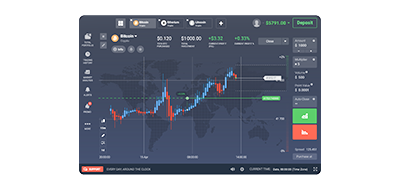Volver
Contents
¿Qué es un mercado alcista?

Demetris Makrides
Senior Business Development Manager

Vitaly Makarenko
Chief Commercial Officer
Un mercado alcista se refiere a un período en el que los precios de los activos, como las acciones, suben de forma persistente o se prevé que sigan creciendo en el futuro. Es un momento en el que los inversores tienen mayor confianza y expectativas favorables. Este artículo profundiza en las particularidades de los mercados alcistas, examinando sus características clave, factores impulsores, etapas y los enfoques de inversión que suelen utilizar los inversores.
Entendiendo un mercado alcista
En el mundo financiero, un mercado alcista significa más que un simple aumento repentino de los precios. Denota una fase en la que los precios suben de forma constante, a menudo con ganancias notables. Generalmente se reconoce cuando un índice general del mercado, como el S&P 500, experimenta un aumento del 20 % o más desde su mínimo. Este impulso positivo refleja bases sólidas, como el crecimiento de las ganancias corporativas, las bajas tasas de desempleo y un PIB en expansión. En épocas de mercados alcistas que pueden durar meses o incluso años, la confianza de los inversores tiende a aumentar. Más personas se unen al mercado, lo que a su vez impulsa el impulso alcista.
El optimismo también se observa en sectores no tradicionales como las materias primas y el sector inmobiliario. En los últimos dos años, las criptomonedas han ganado terreno mostrando patrones optimistas, a pesar de su volatilidad inherente. Esto puede atribuirse a diversas causas, como los avances tecnológicos y los cambios legislativos, que generan un impulso alcista sustancial.
En un mercado alcista, el sentimiento de los inversores pasa de cauteloso o bajista a optimista o alcista como una de sus características definitorias. Esta positividad se ve impulsada por factores como indicadores económicos sólidos, iniciativas gubernamentales favorables y repuntes tras las caídas del mercado. Con la afluencia de inversores que anticipan subidas de precios, la demanda aumenta, impulsando los precios al alza y estableciendo un ciclo autosostenible. En un mercado alcista, la perspectiva positiva y el aumento de las operaciones son indicadores que podrían resultar en un crecimiento sustancial del patrimonio para los inversores prudentes.
Características de un mercado alcista
En un mercado alcista, existen elementos específicos que lo distinguen de otros escenarios de mercado. La característica principal y más evidente es el aumento del valor de los activos en diversos sectores. Esta tendencia alcista no se limita a un solo sector ni a un solo tipo de activo, sino que suele reflejar una mejora general de la situación económica que impacta positivamente en múltiples sectores de la economía.
En un escenario de mercado alcista, los inversores suelen ser optimistas sobre la dirección del mercado. Esta perspectiva positiva no solo sigue la tendencia de los precios, sino que, de hecho, contribuye significativamente a impulsarlos aún más. Cuando los inversores confían en la expansión del mercado, tienden a inclinarse por activos de mayor riesgo, como acciones, criptomonedas y acciones de mercados emergentes. Esta adopción entusiasta de estos activos se debe a la perspectiva de mayores ganancias y puede generar un aumento de la actividad comercial y una liquidez del mercado mucho mayor de lo habitual.
En el mundo del trading y la inversión en criptomonedas, las tendencias pueden fluctuar drásticamente durante los mercados alcistas debido a factores como la entrada en juego de nuevas tecnologías, los cambios regulatorios y la evolución de las condiciones económicas generales. Cabe destacar que en 2017, el aumento del valor de las criptomonedas se debió principalmente a la adopción de la tecnología blockchain por parte de más personas y a la rápida expansión de las ofertas iniciales de monedas (OIC). Asimismo, la tendencia alcista más reciente, de 2020 a 2021, se vio impulsada principalmente por la incorporación de las instituciones a las criptomonedas, el surgimiento de las finanzas descentralizadas (DeFi) y el creciente reconocimiento de las monedas digitales como una opción de inversión legítima. El próximo mercado alcista en criptomonedas aparentemente se basará en los ETF de criptomonedas.
Durante las tendencias alcistas del mercado, estos suelen experimentar un aumento en la actividad comercial y un mayor interés de los inversores a medida que los precios suben, lo que atrae a más participantes que buscan beneficiarse del movimiento alcista. El establecimiento de un ciclo de refuerzo positivo que puede extender el período de optimismo y crecimiento del mercado es posible gracias al aumento de la entrada de fondos, que impulsa los precios al alza.
Los mercados alcistas no son eternos, por lo que es importante recordarlo. Cuando los precios suben significativamente, los valores alcanzan niveles que generan preocupación por la sobrevaloración y la posibilidad de una caída o reversión del mercado. Comprender las características y el funcionamiento interno de un mercado alcista puede ayudar a los inversores a tomar decisiones informadas y a navegar estas fases de crecimiento con mayor eficacia. Ya sea en los mercados financieros o en el ámbito de las criptomonedas, ser capaz de identificar los indicios de un mercado alcista y responder adecuadamente puede contribuir en gran medida al éxito en inversiones a corto y largo plazo.
Factores que impulsan un mercado alcista
Una combinación de circunstancias y factores económicos y psicológicos suele impulsar un mercado alcista y es la base del impulso al alza del valor de los activos. En el ámbito económico, una economía floreciente con un sólido crecimiento del PIB, bajas tasas de desempleo y crecientes beneficios para las empresas sienta las bases para un mercado alcista. Estas señales económicas favorables apuntan a que las empresas obtendrán buenos beneficios, un gasto de consumo sólido y un crecimiento general de la actividad económica. Este tipo de entorno fomenta naturalmente la confianza de los inversores y una mayor inclinación a invertir en acciones y otros activos.
La política monetaria también influye en los mercados alcistas. Cuando los bancos centrales implementan políticas como la reducción drástica de los tipos de interés o la flexibilización cuantitativa, se reduce el coste del crédito. Unos tipos de interés más bajos facilitan que las empresas financien su crecimiento y que los ciudadanos se endeuden y se den un capricho, lo que a su vez impulsa la expansión económica. Además, dado que la rentabilidad de las inversiones, como los bonos, es menor con tipos de interés más bajos, los inversores suelen recurrir al mercado de valores en busca de rentabilidad, lo que impulsa el alza de los precios de diversas inversiones. Estimular la economía mediante medidas bancarias puede impulsar significativamente una tendencia alcista.
Las emociones y la mentalidad de los inversores también son factores que impulsan las tendencias alcistas en el mercado bursátil. Las buenas noticias, como los buenos informes financieros o los avances tecnológicos, pueden generar esperanza y optimismo en los inversores sobre el futuro de sus inversiones, lo que los impulsa a comprar más acciones anticipando el crecimiento y mayores beneficios. Cuando los inversores creen que los precios seguirán subiendo debido a noticias y acontecimientos positivos, se refuerza la confianza en la trayectoria del mercado. Esto puede desencadenar un ciclo en el que el aumento de precios atrae a aún más compradores deseosos de subirse a la ola del éxito. El optimismo en el mercado de criptomonedas puede verse amplificado por factores como la adopción generalizada, la claridad legal o el progreso técnico, lo que resulta en rápidos aumentos de precios.
Factores como el impulso del mercado y las acciones de los inversores también pueden contribuir a impulsar una tendencia alcista que impulse los precios en la trayectoria ascendente. Los inversores impulsados por el impulso y los sistemas de trading automatizado podrían entrar en el mercado a medida que los precios suben, impulsando así aún más el impulso. Los grandes actores del mercado, como los fondos de pensiones y los fondos de cobertura, pueden influir en el comportamiento del mercado gracias a sus importantes inversiones de capital. Cuando estas organizaciones aumentan sus inversiones y exposición en los mercados de acciones u otros instrumentos financieros, pueden generar una mayor actividad de compra que refuerza el impulso general del mercado alcista.
Fases de un mercado alcista
En la mayoría de los casos, los mercados alcistas siguen etapas específicas, con patrones de mercado y actitudes de los inversores únicos en cada fase. Conocer estas etapas puede ayudar a los inversores a navegar por el mercado y tomar buenas decisiones.
La etapa inicial de un mercado alcista suele darse tras la finalización de un mercado bajista o un período de declive económico. Los precios suelen ser más bajos durante esta fase. Existe un pesimismo general entre los inversores, y algunos aún se muestran cautelosos ante nuevas caídas del mercado. Sin embargo, a medida que ciertas señales económicas muestran progreso, como el aumento de las ganancias corporativas, el gasto de los consumidores o las estrategias monetarias positivas, los inversores inteligentes empiezan a vislumbrar la posibilidad de un repunte. En estas primeras etapas de un ciclo de mercado alcista, quienes se adaptan rápidamente a las nuevas tendencias empiezan a comprar activos a precios más bajos, lo que impulsa la trayectoria ascendente del mercado.
A medida que la tendencia alcista del mercado entra en su siguiente etapa, las condiciones económicas están en alza y la confianza de los inversores aumenta. Este período suele caracterizarse por el aumento constante de los precios, la reactivación de la actividad comercial y la mayor participación de un mayor número de personas en el mercado. Más inversores comienzan a sumarse, impulsados por los indicadores económicos y la continua tendencia alcista del valor de los activos. Durante esta fase, existe un sentimiento de positividad y la creencia de que los buenos tiempos continuarán. Durante la etapa del ciclo del mercado es cuando se producen la mayor parte de las ganancias, ya que los precios suben y más inversores se suman a la tendencia alcista.
La última etapa de un mercado suele ser la más emocionante y se caracteriza por estar llena de entusiasmo y comportamientos arriesgados y especulativos por parte de los inversores que buscan aprovechar las ganancias potenciales. En esta etapa, se observa el FOMO (miedo a perderse algo), cuando los inversores tienen tanto miedo de perder ganancias que toman decisiones basadas en las emociones y la creencia de que los precios seguirán subiendo. Las inversiones especulativas se generalizan a medida que las personas buscan retornos rápidos. Esta fase también se caracteriza por valores inflados, donde el rápido aumento de los precios de los activos podría no estar justificado por las realidades económicas subyacentes y no puede sostenerse de forma realista. Durante esta etapa del proceso, cuando las ganancias pueden ser sustanciales, es también cuando el mercado es más susceptible a una recesión o un cambio de dirección.
En algún momento, el mercado alcanza su máximo potencial. Los precios se vuelven demasiado altos para sostenerse durante largos períodos. Esto puede ocurrir debido a razones como el aumento de las tasas de interés, la desaceleración económica o eventos políticos adversos que cambian la percepción de la gente sobre el mercado. Cuando los inversores empiezan a vender acciones para obtener ganancias o abandonan el mercado por completo, los precios pueden empezar a bajar, lo que indica que la buena racha está llegando a su fin. Esta caída puede provocar una corrección en el mercado donde los precios bajan un 10% o incluso menos. También podría ser el inicio de un mercado bajista, con caídas de precios más prolongadas y pronunciadas.
En el mundo del trading y la inversión en criptomonedas, estos ciclos pueden ocurrir rápidamente debido a la imprevisibilidad del mercado y a la influencia de las emociones. Conocer las fases de un mercado alcista puede dar ventaja a los inversores, ayudándoles a predecir cuándo podrían cambiar de dirección y a tomar decisiones más inteligentes sobre dónde invertir su dinero y cuándo retirarlo.
Invertir en un mercado alcista
En un mercado alcista, se aprovecha al máximo el aumento de los precios de los activos, prestando atención a los riesgos. Una estrategia común y sencilla es comprar y mantener activos a largo plazo, con la expectativa de que los precios suban de forma constante en el mercado alcista. Este método permite a los inversores disfrutar del valor creciente de sus inversiones a medida que el mercado sigue subiendo. En un mercado alcista duradero, caracterizado por una tendencia general positiva constante, es donde esta estrategia realmente destaca en términos de eficacia.
En un mercado alcista, una estrategia de promedio del costo en dólares puede ser muy efectiva. Esto implica invertir en activos a intervalos regulares con la misma cantidad de dinero, independientemente de sus precios actuales. Con esta estrategia se evitan los riesgos de intentar predecir el mercado a la perfección y mitigar las consecuencias de las fluctuaciones a corto plazo.
Es fundamental contar con una cartera diversificada para garantizar el éxito de un plan de inversión. Debido a la posibilidad de que sus precios suban, las acciones de crecimiento suelen ser objeto de interés durante un mercado alcista. A pesar de ello, es recomendable que los inversores diversifiquen sus carteras incluyendo activos que históricamente han mostrado crecimiento en períodos de alza en los mercados. Esto podría incluir sectores como la tecnología, la inversión discrecional y los servicios financieros, que suelen tener un buen rendimiento cuando la confianza económica es alta. En la inversión en criptomonedas, es vital distribuir las inversiones entre una gama de monedas y tokens. Esto incluye opciones como Bitcoin y Ethereum, junto con altcoins más recientes que podrían ofrecer prometedoras perspectivas de crecimiento. Además, añadir otros tipos de inversiones, como materias primas, bienes raíces o acciones globales, puede ayudar a diversificar la cartera y abrir nuevas vías de crecimiento y rentabilidad.
Los inversores con mayor tolerancia al riesgo y dispuestos a tomar decisiones audaces en el mercado pueden considerar el trading con margen: utilizar fondos prestados para mejorar sus posiciones de inversión y así aumentar sus ganancias en condiciones de mercado favorables, como una racha alcista o una tendencia alcista en el ciclo del mercado. Sin embargo, es fundamental que estas personas comprendan que esta estrategia conlleva mayores riesgos, ya que las pérdidas potenciales pueden aumentar significativamente si las condiciones del mercado se tornan desfavorables o experimentan una caída inesperada. Por lo tanto, es fundamental que quienes opten por estrategias de apalancamiento tengan un plan definido para salir de sus posiciones y sean conscientes de la probabilidad de enfrentar llamadas de margen en caso de fluctuaciones repentinas y adversas en los niveles de precios.
Algunos inversores podrían optar por la rotación sectorial, trasladando sus inversiones a sectores con un buen rendimiento previsto durante las distintas fases de un ciclo alcista. Durante las fases iniciales de un mercado alcista, las acciones cíclicas, como las de los sectores industrial o financiero, pueden experimentar ganancias sustanciales a medida que la economía comienza a recuperarse. A medida que avanza el mercado alcista, las acciones tecnológicas y orientadas al crecimiento podrían predominar a medida que la expansión económica cobra impulso, lo que permite a los inversores maximizar la rentabilidad y, al mismo tiempo, equilibrar los diversos riesgos del mercado.
Conclusión
Es fundamental que los inversores comprendan el concepto y el funcionamiento de un mercado alcista para aprovechar eficazmente las tendencias de los mercados financieros. Al reconocer las etapas de un mercado alcista y utilizar diversas tácticas de inversión, teniendo en cuenta los riesgos, los inversores pueden sortear estos períodos de crecimiento con mayor seguridad y maximizar sus oportunidades de obtener ganancias financieras.
Actualizado:
19 de diciembre de 2024




